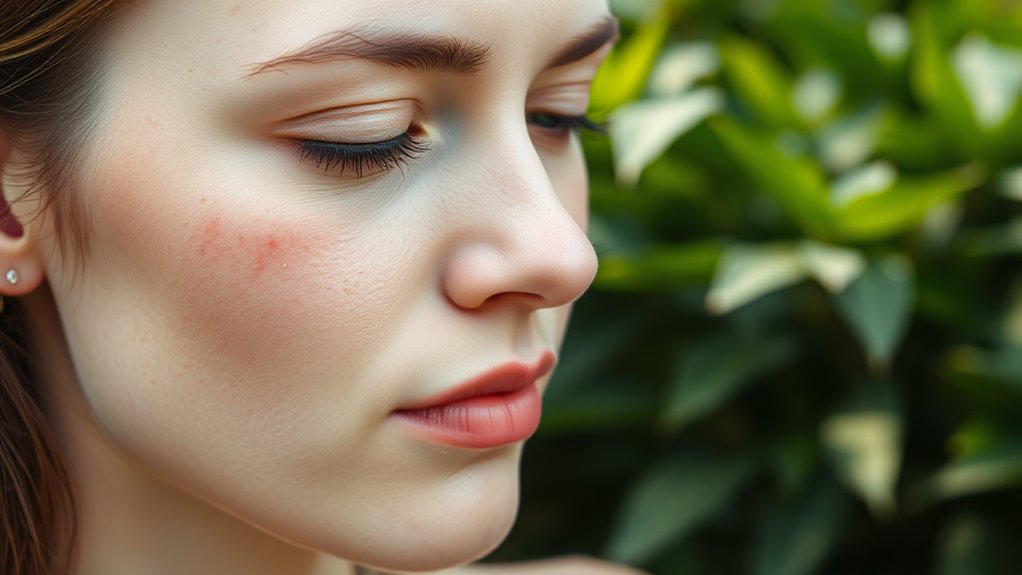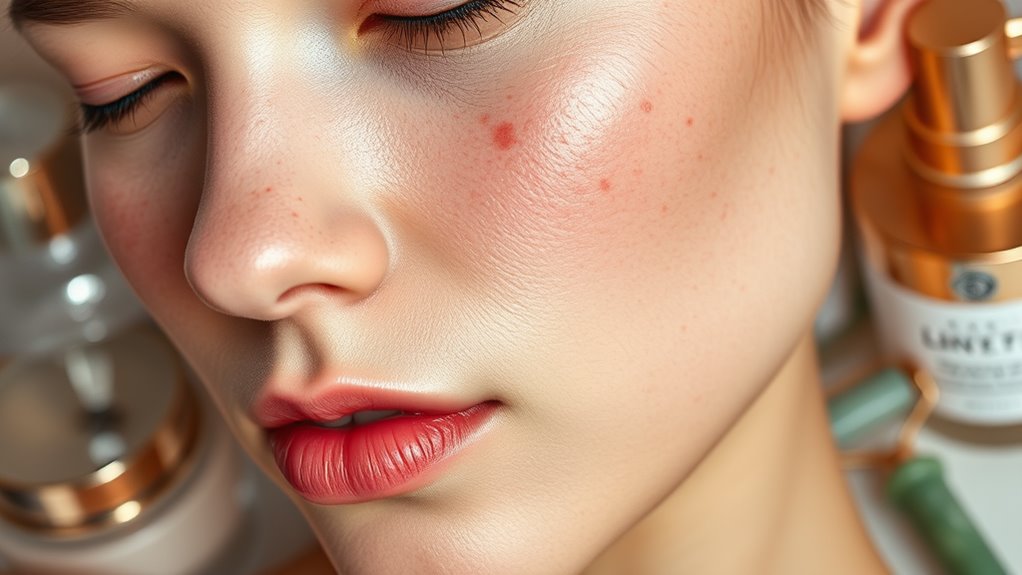Don’t Ignore These Signs of Sensitive Skin
Don’t ignore signs of sensitive skin like redness, irritation, dryness, and itching. These symptoms can lead to discomfort and long-term damage if overlooked. Pay attention to tightness after cleansing, increased reactivity to products, and the appearance of rashes or hives. Visible blood vessels and rough textures can also indicate sensitivity. Addressing these issues early with gentle, hypoallergenic products is crucial for maintaining healthy skin. Discovering effective management strategies can help improve your skin’s health and comfort.
Key Takeaways
- Redness and irritation can indicate sensitivity; identify triggers and switch to hypoallergenic products to prevent worsening symptoms.
- Dryness and tightness after cleansing suggest harsh products; use gentle, hydrating cleansers to restore skin moisture.
- Itching and burning sensations are signs of skin reacting to irritants; simplify your skincare routine to minimize exposure to allergens.
- Visible blood vessels and rough skin texture may indicate sensitivity; protect your skin with sunscreen and adjust routines seasonally.
- Rashes or hives can signal allergic reactions; monitor triggers and seek medical advice for severe symptoms to prevent further damage.
Redness and Irritation
When you notice redness and irritation on your skin, it’s often a clear sign that your skin is sensitive. These sensitive skin symptoms can manifest as rashes, burning, or stinging sensations following exposure to certain products or environments.
You might find that your skin reacts more intensely to temperature changes, harsh weather, or specific ingredients in cosmetics and skincare. Recognizing these signs early is crucial; ignoring them can lead to more severe reactions or chronic discomfort. Additionally, understanding sensitive skin symptoms can help you identify triggers and improve your skincare routine.
To manage your sensitive skin effectively, consider using gentle, hypoallergenic products and avoid known irritants. Pay attention to your skin’s responses and adjust your routine accordingly, fostering a healthier, more resilient complexion in the long run.
Dryness and Flakiness
If you’re experiencing dryness and flakiness, it’s crucial to understand the underlying causes. Factors such as environmental conditions, harsh skincare products, and dehydration can contribute to this issue. Additionally, hidden causes of dry skin may be at play, which often go unnoticed but can significantly impact your skin’s health.
Causes of Dryness
Dryness and flakiness can stem from various factors that disrupt your skin’s natural barrier. Environmental elements, such as low humidity, harsh winds, or extreme temperatures, can quickly sap moisture from your skin.
Additionally, over-cleansing or using products with strong detergents may strip away natural oils, leading to irritation. Certain skin conditions, like eczema or psoriasis, can also contribute to persistent dryness.
Nutritional deficiencies, particularly in essential fatty acids or vitamins, play a significant role too. Moreover, some medications may have side effects that exacerbate dryness.
Identifying the underlying causes is crucial, as it enables you to take targeted steps to restore your skin’s hydration and improve its overall health. Understanding these factors empowers you to make informed choices for your skin.
Effective Moisturizing Tips
Addressing dryness and flakiness starts with effective moisturizing techniques that restore and maintain your skin’s hydration.
First, choose a moisturizer rich in humectants like hyaluronic acid or glycerin, which draw moisture into your skin. Apply it while your skin is still damp to lock in hydration.
Incorporate occlusives such as shea butter or petroleum jelly to create a barrier that prevents moisture loss. It’s crucial to moisturize at least twice a day, especially after cleansing.
Avoid products with alcohol and fragrances, as they can exacerbate sensitivity. Additionally, consider using a humidifier in dry environments to maintain moisture levels.
Itching and Burning Sensation
When you experience an itching and burning sensation on your skin, it often signals that your skin is sensitive and reacting to irritants or allergens. This discomfort can result from various factors, including harsh skincare products, environmental pollutants, or certain fabrics.
It’s crucial to identify the triggers to manage your skin effectively. Start by evaluating your skincare routine and eliminating potential irritants. Opt for fragrance-free, hypoallergenic products designed for sensitive skin.
Additionally, consider the impact of stress and diet on your skin’s health, as they can exacerbate sensitivity. Understanding sensitive skin can help you make informed choices about your skincare products and routines. If the itching and burning persist or worsen, consult a dermatologist to explore underlying conditions and personalized treatment options.
Addressing these symptoms promptly can help restore your skin’s comfort and balance.
Tightness After Cleansing
If you experience tightness after cleansing, it could signal that your skin is reacting to the products you’re using or the cleansing technique itself.
This sensation often stems from stripping your skin of its natural oils, leading to discomfort. Fortunately, there are effective solutions to alleviate this tightness and restore your skin’s balance. Incorporating gentle cleansing into your routine can help maintain hydration while effectively removing impurities.
Causes of Tightness
Tightness after cleansing can signal that your skin is reacting negatively to the products or methods you’re using. This sensation often arises from over-cleansing, which strips away essential oils, disrupting your skin’s natural barrier.
Harsh ingredients, like sulfates or alcohol, can further exacerbate this issue by drying out the skin and causing irritation. Additionally, using hot water during your cleansing routine can lead to increased sensitivity and tightness.
Environmental factors, such as low humidity or extreme temperatures, may also contribute to your skin’s discomfort. If you’re experiencing persistent tightness, it’s crucial to assess your cleansing products and techniques, as these can significantly impact your overall skin health and comfort.
Solutions for Relief
Finding relief from tightness after cleansing starts with reassessing your skincare routine. Focus on using gentle, hydrating cleansers that maintain your skin’s moisture barrier. Incorporate soothing ingredients like aloe vera or chamomile. Additionally, consider the timing of your skincare application; applying moisturizers while your skin is still damp can enhance hydration.
| Step | Recommendation |
|---|---|
| Cleanser | Use a sulfate-free option |
| Moisturizer | Choose a cream or balm |
| Frequency | Limit to twice daily |
| Additional Care | Consider a hydrating serum |
Increased Reactivity to Products
As you explore skincare products, you might notice an increased reactivity in your skin, which can signal sensitivity. This heightened response can manifest as redness, stinging, or burning upon application.
It’s crucial to pay attention to how your skin reacts to various ingredients, especially fragrances, alcohols, and certain preservatives. If you find that your skin frequently reacts negatively, it’s a clear indication that these products may not be suitable for you.
Consider simplifying your routine and opting for products labeled as hypoallergenic or designed for sensitive skin. Patch testing new products before full application can also help you gauge their compatibility. Additionally, incorporating gentle products into your regimen can significantly improve your skin’s tolerance over time.
Ultimately, understanding your skin’s reactivity will empower you to make informed choices for a healthier complexion.
Frequent Breakouts
In addition to increased reactivity, frequent breakouts can also indicate that your skin is sensitive. When you notice these breakouts, it’s essential to analyze potential triggers that might be exacerbating your skin’s condition.
Sensitive skin often reacts poorly to various factors, leading to inflammation and breakouts. Consider the following:
-
Harsh Ingredients: Products with alcohol or strong fragrances can irritate sensitive skin.
-
Environmental Stressors: Pollution, heat, and humidity can overwhelm your skin, leading to breakouts.
-
Dietary Factors: Certain foods, especially those high in sugar or dairy, may contribute to skin sensitivity.
Addressing these triggers is vital for maintaining skin health and reducing breakouts.
Prioritize gentle, suitable products to help restore balance to your skin.
Visible Blood Vessels
Visible blood vessels can be a concerning sign of sensitive skin, often resulting from factors like sun exposure or genetics.
Understanding the causes behind these vessels, exploring treatment options, and implementing prevention strategies can help you manage this condition effectively.
Let’s examine how you can address and minimize the appearance of visible blood vessels.
Causes of Visible Blood Vessels
While various factors can contribute to the appearance of visible blood vessels on the skin, understanding the underlying causes is essential for effective management.
Here are some common causes you should consider:
-
Genetics: Family history can play a significant role in your skin’s susceptibility to visible blood vessels.
-
Environmental Factors: Sun exposure, extreme temperatures, and pollution can weaken blood vessel walls, causing them to become more noticeable.
-
Lifestyle Choices: Activities like smoking, excessive alcohol consumption, and a poor diet may lead to inflammation and vascular issues, exacerbating the visibility of blood vessels.
Treatment Options Available
Addressing the presence of visible blood vessels often involves a combination of lifestyle adjustments and medical treatments. Start by implementing gentle skincare routines and avoiding harsh products that can irritate your skin. Incorporating antioxidants, like vitamins C and E, can enhance your skin’s resilience.
For more severe cases, consider consulting a dermatologist about treatments such as laser therapy, which targets and reduces the appearance of these vessels effectively. Intense pulsed light (IPL) therapy is another option that can help in diminishing redness. Additionally, sclerotherapy may be suitable for larger veins.
Always prioritize sun protection with a broad-spectrum sunscreen, as UV exposure can exacerbate the issue. Together, these strategies can significantly improve your skin’s appearance and health.
Prevention Strategies to Consider
To prevent the appearance of blood vessels on your skin, it’s crucial to adopt a proactive approach in your daily routine.
Implementing effective strategies can significantly minimize your risk. Consider these key practices:
-
Use sunscreen daily: Shield your skin from harmful UV rays, which can weaken blood vessels.
-
Avoid extreme temperatures: Protect your skin from hot showers and cold winds to reduce irritation.
-
Maintain a healthy lifestyle: Focus on a balanced diet rich in antioxidants and stay hydrated to support skin health.
Stinging or Tingling Sensation
If you experience a stinging or tingling sensation on your skin, it could be a sign of sensitivity. This sensation often arises in response to certain products or environmental factors.
For instance, harsh ingredients, extreme temperatures, or even friction can trigger this discomfort. Pay attention to when it occurs—after applying a new moisturizer or after sun exposure, for example.
It’s crucial to identify the source to prevent further irritation. Consider patch-testing new products and opting for those formulated for sensitive skin.
Additionally, maintaining a consistent skincare routine can help strengthen your skin’s barrier, reducing sensitivity.
If the stinging persists or worsens, consult a dermatologist for tailored advice and potential treatment options.
Allergic Reactions
While your skin might react to various products or environmental factors, allergic reactions can be particularly alarming.
These reactions often occur when your immune system identifies a substance as harmful, leading to irritation and discomfort. Recognizing the signs is crucial for effective management.
Here are some common triggers to consider:
-
Fragrances: Many skincare products contain synthetic fragrances that can provoke allergic responses.
-
Preservatives: Chemicals used to prolong shelf life may irritate sensitive skin.
-
Dyes: Colorants in cosmetics can lead to unexpected allergic reactions.
If you suspect an allergic reaction, discontinue use of the offending product and consult a dermatologist for guidance.
Prompt action is vital to prevent further skin damage and restore balance to your complexion.
Rash or Hives
Allergic reactions can sometimes manifest as a rash or hives, making it important to recognize these symptoms early.
You might notice red, itchy welts on your skin that can vary in size and shape. Hives often appear suddenly and can result from allergens such as food, medications, or environmental triggers.
Pay attention to accompanying symptoms like swelling or difficulty breathing, as these may indicate a more severe reaction.
If you experience a rash or hives, it’s essential to identify the trigger and avoid further exposure.
Over-the-counter antihistamines can provide relief, but persistent or severe cases require medical attention.
Understanding your skin’s reactions can help you manage sensitivities effectively and maintain optimal skin health.
Rough or Bumpy Texture
A rough or bumpy texture on your skin can indicate sensitivity, often leading to discomfort and self-consciousness. This texture might arise from various factors, including irritation, dryness, or an allergic reaction.
To address this issue effectively, consider the following:
-
Gentle Cleansing: Use mild, fragrance-free cleansers to avoid further irritation.
-
Moisturization: Apply a rich, hydrating moisturizer regularly to maintain skin barrier function.
-
Exfoliation: Incorporate gentle exfoliation to remove dead skin cells, but avoid harsh scrubs that can exacerbate sensitivity.
Identifying and managing the underlying causes of a rough texture is essential.
Sensitivity to Temperature Changes
Many people with sensitive skin find that their complexion reacts strongly to temperature changes, whether it’s the chill of winter air or the heat of summer sun. These fluctuations can lead to redness, irritation, or even breakouts. Understanding how temperature affects your skin is crucial for managing its health.
| Temperature Condition | Skin Reaction |
|---|---|
| Cold Weather | Redness, dryness |
| Hot Weather | Oiliness, irritation |
| Sudden Changes | Flushing, sensitivity |
| Humidity | Breakouts, clogged pores |
| Air Conditioning | Dryness, flakiness |
To mitigate discomfort, consider adjusting your skincare routine seasonally. Use hydrating products in winter and lightweight formulas in summer to maintain your skin’s balance.




